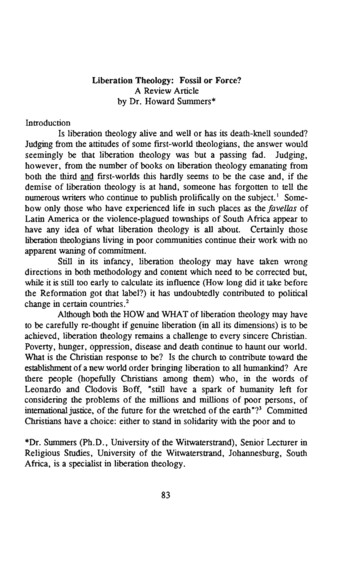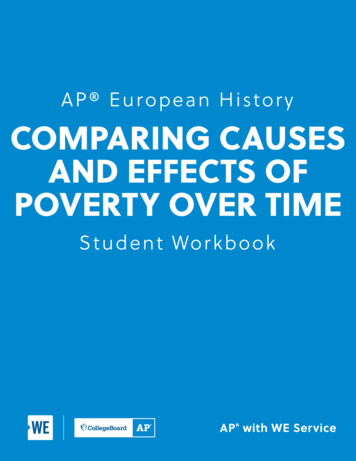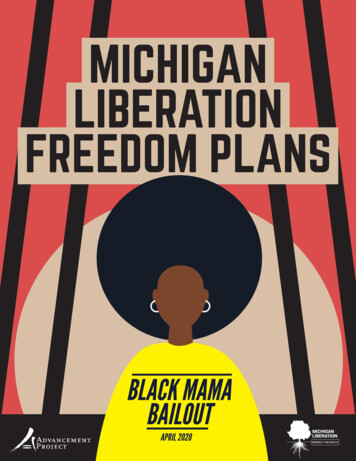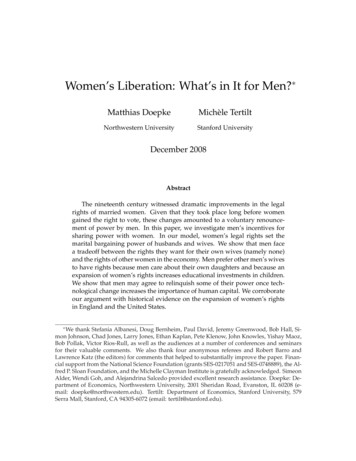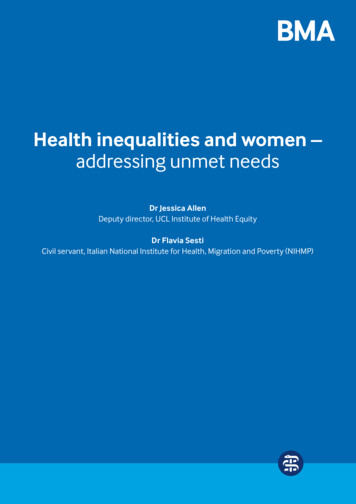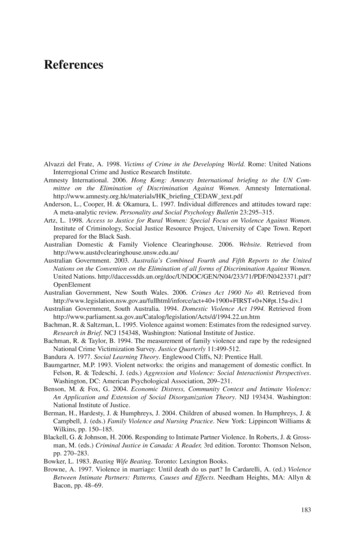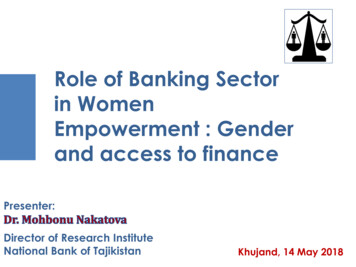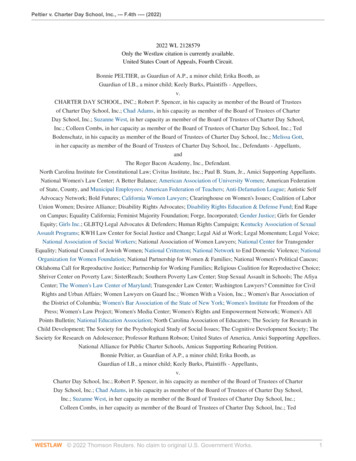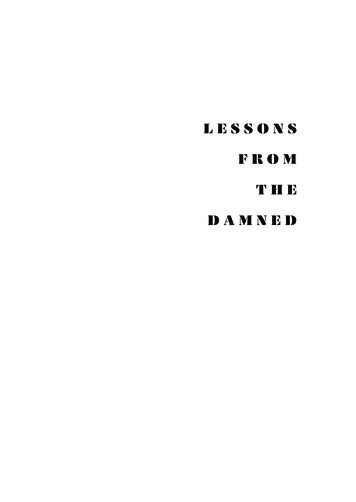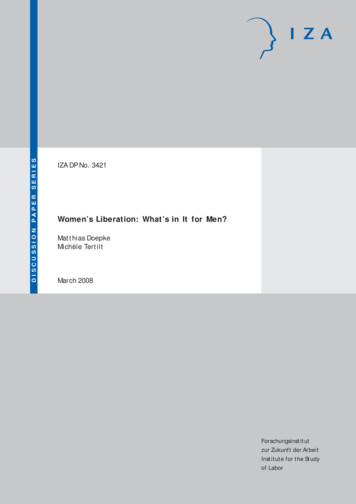
Transcription
DISCUSSION PAPER SERIESIZA DP No. 3421Women’s Liberation: What’s in It for Men?Matthias DoepkeMichèle TertiltMarch 2008Forschungsinstitutzur Zukunft der ArbeitInstitute for the Studyof Labor
Women’s Liberation:What’s in It for Men?Matthias DoepkeUniversity of California, Los Angeles,CEPR, NBER and IZAMichèle TertiltStanford University,NBER and CEPRDiscussion Paper No. 3421March 2008IZAP.O. Box 724053072 BonnGermanyPhone: 49-228-3894-0Fax: 49-228-3894-180E-mail: iza@iza.orgAny opinions expressed here are those of the author(s) and not those of IZA. Research published inthis series may include views on policy, but the institute itself takes no institutional policy positions.The Institute for the Study of Labor (IZA) in Bonn is a local and virtual international research centerand a place of communication between science, politics and business. IZA is an independent nonprofitorganization supported by Deutsche Post World Net. The center is associated with the University ofBonn and offers a stimulating research environment through its international network, workshops andconferences, data service, project support, research visits and doctoral program. IZA engages in (i)original and internationally competitive research in all fields of labor economics, (ii) development ofpolicy concepts, and (iii) dissemination of research results and concepts to the interested public.IZA Discussion Papers often represent preliminary work and are circulated to encourage discussion.Citation of such a paper should account for its provisional character. A revised version may beavailable directly from the author.
IZA Discussion Paper No. 3421March 2008ABSTRACTWomen’s Liberation: What’s in It for Men?*The nineteenth century witnessed dramatic improvements in the legal rights of marriedwomen. Given that these changes took place long before women gained the right to vote,they amounted to a voluntary renouncement of power by men. In this paper, we investigatemen’s incentives for sharing power with women. In our model, women’s legal rights set themarital bargaining power of husbands and wives. We show that men face a tradeoff betweenthe rights they want for their own wives (namely none) and the rights of other women in theeconomy. Men prefer other men’s wives to have rights because men care about their owndaughters and because an expansion of women’s rights increases educational investmentsin children. We show that men may agree to relinquish some of their power oncetechnological change increases the importance of human capital. We corroborate ourargument with historical evidence on the expansion of women’s rights in England and theUnited States.JEL Classification:Keywords:D13, E13, J16, N30, O43women's rights, political economy, human capital, return to education,economic growthCorresponding author:Matthias DoepkeDepartment of EconomicsUniversity of California, Los Angeles405 Hilgard AveLos Angeles, CA 90095-1477USAE-mail: doepke@econ.ucla.edu*We thank Stefania Albanesi, Jeremy Greenwood, Bob Hall, Simon Johnson, Larry Jones, EthanKaplan, Pete Klenow, John Knowles, Yishay Maoz, Bob Pollak, Victor Rios-Rull, as well as theaudiences at a number of conferences and seminars for valuable comments that helped to improvethe paper. Financial support from the National Science Foundation (grants SES-0217051 and SES0519324), the Alfred P. Sloan Foundation, and the Michelle Clayman Institute is gratefullyacknowledged. Simeon Alder, Wendi Goh, and Alejandrina Salcedo-Cisneros provided excellentresearch assistance.
1 Introduction“Once married, a bride was obliged by law and custom to obey her husband—a requirement so fundamental to the biblical idea of a wife that it remained inmost Jewish and Christian wedding vows until the late twentieth century. Afterall, wives were considered a husband’s ‘property,’ alongside his cattle and hisslaves.”Marilyn Yalom, A History of the Wife (2001)The cause of gender equality has made dramatic progress over the past 200 years.Today, the expansion of political rights through female suffrage, introduced in1918 in the United Kingdom and in 1920 in the United States, is often regarded asthe main breakthrough. However, important changes in women’s economic rightstook place much earlier. In England and the United States (which have similarcommon-law legal systems), this is especially true for the rights of married women. Prior to 1830, in these countries married women essentially had no rights atall. Upon marriage, the legal rights of husband and wife were merged and subsequently exercised solely by the husband. Married women had no rights withregard to their legitimate children, they could not own property, and they couldnot obtain a divorce. In short, a married woman had no separate legal existenceof her own.1 Throughout the nineteenth century, both England and the UnitedStates carried out a series of reforms in areas such as child custody, divorce, andmarital property law that substantially altered the rights and obligations of husbands and wives during and after marriage.2 By the end of the century, the rights1The English common law makes the legal distinction between a feme sole, a single woman whohad some legal rights, and a feme covert, a married woman with no rights of her own. The legalimpotence of married women in the mid-nineteenth century is famously summarized in Elizabeth Cady Stanton’s “Seneca Falls Declaration” for the United States (Stanton 1848) and CarolineNorton’s pamphlet “A Letter to the Queen on Lord Chancellor Cranworth’s Marriage and Divorce Bill” for England (Norton 1855). An extensive description of the rights and obligations ofwives in sixteenth and seventeenth century England can be found in Stone (1977).2Among the earliest changes was a shift in child custody rules, with Iowa being the first U.S.state to grant some custody rights to mothers in 1838 and the Custody of Infants Act that passedin England in 1839. This was followed by changes in divorce laws in the mid-nineteenth centurysuch as the Matrimonial Causes Act of 1857 in England. The Married Women Property Acts of 1870and 1882 enabled married women in England to have control over their earnings, to own separateproperty, and to write contracts. Similarly, almost all U.S. states established some form of marriedwomen’s property rights by the end of the nineteenth century. A detailed time line of these1
of husbands and wives in these areas were close to being equal.Our research is motivated by the observation that this dramatic improvement ofmarried women’s economic rights took place before women were granted politicalrights. All the reform laws of this period were passed by all-male legislatures thatwere accountable only to male voters. Given that the granting of rights to womenimplied a weakening of men’s rights, it amounted to a voluntary renouncementof power by men. This brings us to our main question: Why would men everagree to grant more rights to women?The idea put forth in this paper is that from a man’s perspective, there is a tradeoffbetween the rights of his own wife versus the rights of other men’s wives. Improvements in married women’s legal rights increase women’s bargaining powerrelative to their husbands within the household. Since husbands have nothing togain from an increase in their wives’ bargaining power at their own expense,men ideally want their own wives to have no rights. But men might stand togain from other women having rights. We focus on two channels that give mena stake in the rights of other men’s wives. First, men are altruistic towards theirown children, half of which are daughters. Men prefer their daughters to have astrong bargaining position vis-à-vis their sons-in-law.3 Second, in our model animproved bargaining position for wives translates, among other things, into increased investments in children’s human capital. A father prefers his children tofind high-quality mates, and therefore stands to gain from increasing the powerof his children’s future mothers-in-law.We argue that this tradeoff between the rights of a man’s own wife versus thoseof other men’s wives has shifted over time, because of a changing role of humancapital. When the return to education increases, finding well-educated spousesfor one’s children becomes a more important concern. Similarly, a rising returnto education also increases fathers’ concern about the rights of their daughters,because the daughter’s marital bargaining power matters for the grandchildren’seducation. According to our theory, the ultimate cause of the expansion of women’s rights throughout the nineteenth century was technological change thatreforms is given in Appendix A.3Washington (2008) and Oswald and Powdthavee (2006) provide empirical evidence thatmen’s political preferences are influenced by their number of daughters.2
increased the demand for human capital. This change elevated the importanceof children’s education, it increased men’s incentives to expand women’s bargaining power, and it ultimately induced men to voluntarily extend rights towomen.The framework for our theoretical analysis is an overlapping-generations modelin which married couples face a tradeoff between the quantity (i.e., number) andquality (i.e., education) of their children. In addition, couples have to allocateconsumption between husband and wife. Our theory builds on the altruisticparents model of Becker and Barro (1988) and Barro and Becker (1989). Wemodify the original setup by explicitly modeling husbands and wives.4 We follow Chiappori (1988, 1992) and model household decision-making by solvinga Pareto problem, with different weights on husband and wife, signifying theirrelative bargaining power. There is disagreement between the spouses in two dimensions. First, even though the spouses are altruistic towards each other, bothhusband and wife value their own consumption more than that of their spouse.Marital bargaining power therefore affects the allocation of consumption. Second, we assume that mothers care more about the well-being of their childrenthan fathers do. Bargaining power therefore also matters for children’s education; in particular, extending rights to women will lead to a better education ofall children.5We then analyze the economic implications of two alternative political regimes.4Papers that analyze two-gender OLG models in non-altruistic settings include Aiyagari,Greenwood, and Guner (2000), Fernández, Guner, and Knowles (2005) and Tertilt (2005).Fernández, Fogli, and Olivetti (2004) also provide a formal model where men’s attitudes towards women change endogenously, although the application is to female labor force participation rather than women’s rights.5The idea that female empowerment leads to higher investments in child quality is alsopresent in Edlund and Lagerlöf (2004), who have a model in which a shift in power towardswomen leads to faster human capital accumulation (see also Iyigun and Walsh 2007b). Eswaran(2002) argues that one reason for such behavior is that women bear relatively higher utility costsof child-bearing (e.g. pains and mortality associated with child-bearing) than men. In anotherempirical contribution, Miller (2008) analyzes the connection between women’s suffrage, publichealth spending, and child survival rates in the U.S. and argues that investment in children increased significantly in response to women having more power. Similar ideas are also extensivelydiscussed in the demography literature (Federici, Mason, and Sogner 1993). In Gould, Moav, andSimhon (2007), the link from female education to investments in children leads to a switch frompolygyny to monogamy once the return to education is sufficiently high.3
Under patriarchy all family decisions are made solely by the husband, whereasunder empowerment decisions are made jointly by husband and wife. We allowmen to vote on the political regime, and we analyze their incentives for supporting empowerment. We find that when returns to education are low, men arebetter off living in patriarchy. As returns to education increase, parents chooseto have fewer children and to educate them more. We show that once returns toeducation reach a critical threshold, men stand to gain from improving women’srights and will vote for empowerment.We corroborate our argument with historical evidence on the expansion of women’s rights in England and the United States. Our theory places the introduction of women’s rights in the context of the demographic transition and the increased accumulation of human capital in the second phase of the industrial revolution.6 We show that the historical timing of increased investments in education,declining fertility, and the expansion of women’s rights is consistent with the implications of our theory. We also show that the historical debates surroundingthe major reforms of women’s rights during this period reflect the key argumentsarticulated by our analysis. Based on evidence from parliamentary debates, proreform pamphlets, and newspaper editorials, we document that in both Englandand the United States there was a gradual shift during the nineteenth centuryfrom arguments that focus on the rights of men towards a view that gives firstpriority to the needs of children.Our theory leads to an interesting reassessment of the relationship between traditional family roles and the progress of women’s liberation. During the twentieth century, a major focus of the women’s liberation movement has been theadvancement of women in the formal labor market. From this perspective, traditional role models and the glorification of motherhood were often viewed asobstacles which the women’s liberation movement aimed to overcome. A longerterm perspective, however, reveals that the “traditional” roles for women andmothers are a relatively recent invention. Social historians document that thesharp distinction between the roles of mothers and fathers in the household as6To this end, our theory builds on unified models of economic and demographic change suchas Galor and Weil (1996), Galor and Weil (2000), Greenwood and Seshadri (2002), Hansen andPrescott (2002), Boldrin and Jones (2002), Doepke (2004), and Jones and Schoonbroodt (2007).4
well as the heightened status of motherhood arose only in the nineteenth century,when industrialization led to a greater separation of home and work spheres andthe nurturing and education of children gained in importance. In our theory, it isexactly the increasingly central role of mothers in the education of their childrenthat triggers improvements in women’s rights.By focusing on the “supply” of rights by men, our approach provides a contrastto theories advanced by historians that focus on the “demand” side by highlighting the role of the women’s movement in achieving gender equality. Within theeconomics literature, there are only a few papers that attempt to explain changesin the legal position of women. Geddes and Lueck (2002) emphasize that women’s rights will expand when an increasing return to female labor induces morewomen to enter the formal labor market. While such arguments may be applicable to more recent changes in women’s rights, they are unlikely to be relevantfor the major reforms of married women’s rights during the nineteenth century,because these occurred long before married women entered the formal labor market in large numbers. As late as 1920 (when female suffrage was introduced atthe federal level), only five percent of married women in the United States werein the labor force. Another strand of the literature focuses specifically on the extension of political rights to women.7 For example, Bertocchi (2007) argues that adecline of the gender wage gap reduced disagreement about the optimal tax ratebetween men and women, which lowered the cost for men to include women inthe franchise. While interesting, this argument is not applicable to the nineteenthcentury reforms of the economic rights of married women, which took place longbefore franchise extension.8The next section sets up the formal model. In Section 3 we analyze men’s incentives to share power with women, and Section 4 describes the transition frompatriarchy to empowerment that is triggered by a rise in the return to educa7Empirical papers on the causes and consequences of female suffrage include Jones (1991),Lott and Kenny (1999), Edlund and Pande (2002), and Funk and Gathmann (2006).8Papers that analyze the general extension of the franchise (not restricted to women) includeAcemoglu and Robinson (2000, 2006), Lizzeri and Persico (2004), Diaz (2000), and Jack and Lagunoff (2006). The arguments in these papers are specific to expansions of political rights. Ourwork is more closely related to Galor and Moav (2006), who argue that an increase in the return toeducation helped overcome the historical conflict between workers and capitalists and inducedcapitalists to support public education.5
tion. Section 5 contains historical evidence from England and the United States.Section 6 concludes and discusses some implications of our theory for economicdevelopment. All proofs are contained in the mathematical appendix.2 A Model of Women’s RightsOur model economy is populated by overlapping generations of men and women who are joined in marriage. Each household is composed of a husband, awife, and their children. Couples have to decide on fertility, the education of theirchildren, and the allocation of consumption between the husband and the wife.Women’s rights are represented as the relative bargaining power of the husbandand the wife in the decision making of the household.9 Women’s rights are endogenous; in particular, men can vote on whether to extend rights to women.The aim of our analysis is to determine how the economic environment affectsmen’s incentives to grant women rights.2.1 Preferences and ConstraintsEach couple in our economy has an equal number of sons and daughters. We usei {m, f } to denote gender (male or female) and i to denote the gender opposite to i. People care about their own consumption ci , their spouse’s consumptionc i , their number of children of each gender n (i.e., n sons and n daughters), and and daughters Uf . The utility functionthe average of the utilities of their sons Umof an adult i with spouse i is given by: , Uf )Ui (ci , c i , n, Um u(ci , c i , n) γi Uf Um2 ,(1)where:u(ci , c i , n) log(ci ) σ log(c i ) δ log(n).9Echevarria and Merlo (1999) use a related two-parent dynastic model to analyze gender differences in education. There is no voting on women’s rights, but men can improve the positionof their daughters by choosing a higher education level, which increases the daughters’ outsideoptions and hence their bargaining positions in marriage.6
Thus, σ is the weight on spousal consumption, and δ is the weight on the numberof children. We assume that 0 σ 1 (people value their spouses’ consumptionless than their own) and δ 0 (people like children). The only gender-specificpart of the utility function is the weight γi 0 attached to the welfare of thechildren.A central assumption of our model is that women attach relatively more weightto the welfare of their children than men do, i.e., γf γm . There is a substantialempirical literature supporting this assumption. Several studies use natural experiments to show that when women have control of household decisions, theytend to spend more resources on children.10 From an evolutionary perspective,the altruism gap between women and men can be rationalized by higher paternity uncertainty for men (e.g. Anderson 2006) or by the more limited reproductive capacity of women.11Both spouses have one unit of time available. Men use all of their time for work,tm 1, while women split their time between working, tf , and raising and educating children. The assumption that women bear the entire burden of caringfor children is not crucial, but is made for simplicity and realism.12 Weakening oreven reversing this assumption would not alter the main results.The labor effort of men and women is combined by a Cobb-Douglas householdproduction function to produce the consumption good. For a family where thehusband and the wife have human capital Hm and Hf , respectively, the budgetconstraint for consumption is given by:cm cf A(tf Hf )α (tm Hm )1 α ,(2)where 0 α 1.There is a time cost φ for raising each boy-girl pair. In addition, the couple can10See Lundberg, Pollak, and Wales (1997), Pitt and Khandker (1998), Case and Deaton (1998),and Attanasio and Lechene (2002).11Another reason might be that altruism towards children increases in time spent with children,and that women typically do most of the child-rearing.12One reason why women have historically done most of the child-rearing is their ability tobreast-feed and the fact that high-quality breast milk substitutes were only developed in the mid20th century, as documented in Albanesi and Olivetti (2007).7
decide how much time to devote to their children’s education. The time spenteducating the daughters is denoted by ef per daughter, and the time spent educating each son is em . The time constraint for women is thustf (φ em ef )n 1.(3)The point of education is to increase the children’s human capital, which improves their welfare. The laws of motion for human capital are given by: 1 βHm max{1, (Bem )θ Hfβ Hm},(4)1 βHf max{1, (Bef )θ Hfβ Hm},(5) where Hmand Hf denote the human capital of sons and daughters, and the pa-rameters satisfy B 0, θ 0, and 0 β 1. Two features are noteworthy here.First, the human capital of both parents has a positive effect on the productivityof education. Second, even without education (em ef 0) children receive oneunit of human capital, which can be interpreted as the basic productive capacity of an uneducated person (such as the ability to perform unskilled physicaltasks). If the education technology is relatively unproductive (i.e., B or θ is low)the individual choice problem will yield a corner solution in which parents donot educate their children. While this possibility is not crucial for our results,analyzing the no-education case will help illuminate the extent to which humancapital accumulation is a necessary prerequisite for female empowerment.The elasticity parameter θ in the production function for human capital plays animportant role in our analysis. In particular, θ pins down the return to education,i.e., the percentage increase in children’s earnings for a given increase in education time em or ef . We will see below that the level of θ is a key determinant ofmen’s incentives for granting women’s rights.2.2 Determination of Economic ChoicesDecision-making in a household depends on the political regime. Under eitherpolitical regime, the current generation sets only current economic choices. That8
is, there is no possibility of committing future family members to particular decisions. There are two possible political regimes. Under the patriarchy regime, menmake all decisions. Economic choices are therefore determined by maximizingmale utility: {cm , cf , n, em , ef } argmax Um (cm , cf , n, Um, Uf ) ,(6)where the maximization is subject to the constraints (2) to (5) above. In the alternative regime, decisions are made through efficient bargaining between thehusband and the wife with equal weights.13 We call this the empowerment regime.Under this regime, economic choices are given by: {cm , cf , n, em , ef } argmax , Uf ) Uf (cf , cm , n, Um, Uf )Um (cm , cf , n, Um2 , (7)where once again the maximization is subject to (2) to (5). Implicitly, we assume that the government can set the relative bargaining power of the spouses(with women receiving zero weight under patriarchy and equal weight underempowerment).14 The political regime is determined through a vote of the malepopulation, to be described in more detail below.To solve the maximization problems in (6) and (7), we first need to determinehow the children’s utilities are affected by parental choices in each regime. Thiscan be done by formulating the decision problem of a household recursively, sothat all utilities become functions of the state variables. Clearly, the human capital of husband and wife Hm and Hf are state variables for a family. However,13The exact weighting is not essential for the qualitative results. What matters is that the weightof the wife increases relative to patriarchy. See Pollak and Lundberg (1993) and Pollak and Lundberg (2008) for alternative ways of modeling household bargaining. Recent discussions of theimportance of household bargaining for explaining family labor supply include Burda, Hamermesh, and Weil (2007) and Knowles (2007).14Reforms to marital property law improved women’s bargaining position because womengained independent control over their property and earnings. Reforms to divorce and child custody law also mattered because these improved married women’s outside options. For the case ofEngland, Stone (1993) documents why before the nineteenth-century reforms divorce was not ameaningful outside option for women. Women suing for separation would bring extreme financial hardship upon themselves, they would lose control over and in many cases all access to theirchildren, and they would face public humiliation (the only grounds for divorce were extremecruelty or adultery, the details of which would be discussed in court).9
these state variables are not sufficient to describe the decision problem. Parentscare about the welfare of their children, which in turn depends on the humancapital of the children’s future spouses. We assume that the sons and daughtersof a given family do not marry each other, but draw a spouse at random fromother families. We therefore also need a state variable that summarizes the family’s expectations regarding the human capital of their children’s future spouses.Given our setup, these state variables are given by the economy-wide averages ofmale and female human capital, denoted H̄m and H̄f . The aggregate state vectoris written as H̄ {H̄m , H̄f }.15We use VmP and VfP to denote the male and female value functions under patriarchy, and VmE and VfE denote the value functions under empowerment. Foreither gender i {m, f } and under either political regime j {P, E}, the valuefunctions satisfy the recursive relationship: Vij (Hm , Hf , H̄) u(ci, c i , n) γi Vmj (Hm, H̄f , H̄ ) Vfj (H̄m, Hf , H̄ ),2(8)where the economic choices are given by (6) and (7), respectively. The children’sutilities in (6) and (7) as a function of the political regime j are thus given by: Um Vmj (Hm, H̄f , H̄ ),(9) Uf Vfj (H̄m, Hf , H̄ ).(10) Notice that the family has direct control only over the human capital Hmof theirsons and the human capital Hf of their daughters. In contrast, the human capitalof their daughters-in-law and sons-in-law is given by economy-wide averages H̄f and H̄m. These quantities, in turn, are determined by equilibrium laws of15We focus on equilibria in which all dynasties start out with the same initial human capital,in which case individual and aggregate human capital are always equal, Hi H̄i . Nevertheless,the distinction between individual and aggregate variables is essential, because individuals donot internalize their impact on aggregate human capital.10
motion as a function of current average female and male human capital: H̄m Gjm (H̄f , H̄m ),(11)H̄f Gjf (H̄f , H̄m ),(12)which have to be consistent with the individual laws of motion (4) and (5). Therecursive system (6) to (12) can be solved to yield allocations and the welfare ofmen and women under either political regime.2.3 Determination of the Political RegimeThe political regime is determined by a once-and-for-all vote among the malepopulation.16 Before economic decisions are made in the initial period, men canvote on which political regime should be adopted. Men are utility maximizers intheir voting decisions as well. Under the assumption that men will vote for patriarchy when both regimes yield the same utility, empowerment will be adopted ifand only if:VmE (Hm , Hf , H̄) VmP (Hm , Hf , H̄).At first sight, it may appear that patriarchy is advantageous for men. Given thatσ 1, men would like to claim a disproportionate share of consumption forthemselves, and patriarchy allows them to do so. However, there are also frictions in this economy that could make a lopsided distribution of power unattractive to men. First, men care about their daughters, and do not want their sons-inlaw to have too much power over them. Second, the political regime also affectsthe accumulation of human capital, which may provide additional motives formen to support women’s rights. In what follows, we examine these tradeoffs inmore detail, and derive conditions under which men prefer to share power withtheir wives.16Our focus on a once-and-for-all vote is consistent with the finding below that in the relevantcases the tradeoff between the political regimes depends only on parameters, and not on statevariables. If there are changes in parameters over time, on the other hand, dynamic voting wouldbe a more natural concept. We will address this issue in Section 4.11
3 Men’s Incentives for Voting for EmpowermentTo determine how men’s utility is affected by women’s rights, we need to solvethe recursive system (6) to (12) and then compare the male value functions undereach political regime. It will be useful to carry out this analysis separately depending on whether parents invest in the education of their children. We will seethat even if parents do not educate their children, men have a motive to supportwomen’s rights because of their concern for their daughters. However, we arguethat this motive is unlikely to be strong enough to explain female empowerment.In contrast, we show that if parents educate their children and the re
University of California, Los Angeles, CEPR, NBER and IZA Michèle Tertilt Stanford University, NBER and CEPR Discussion Paper No. 3421 March 2008 IZA P.O. Box 7240 53072 Bonn Germany Phone: 49-228-3894- Fax: 49-228-3894-180 E-mail: iza@iza.org Any opinions expressed here are those of the author(s) and not those of IZA.
